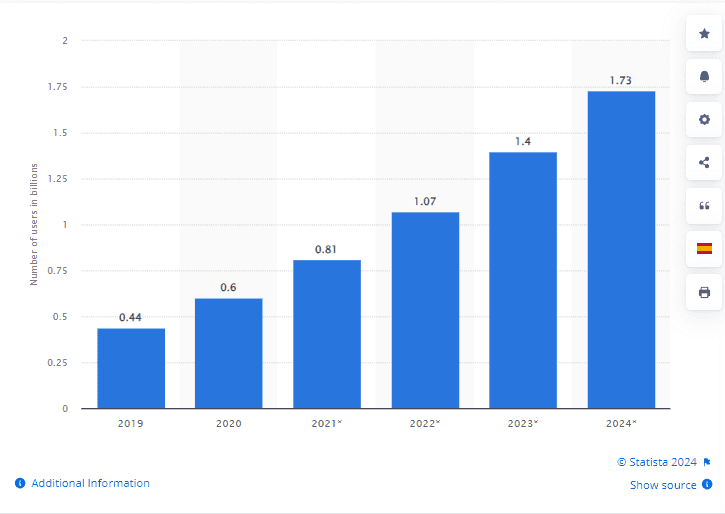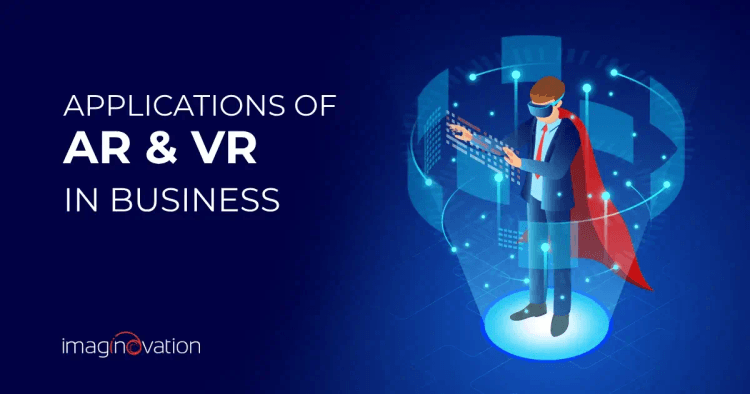Have you ever wished to step into a comic book while reading one? Or roam freely in a medieval castle when learning about it? Or see how a new wall paint color could transform your living room space.
Well, buckle up because the thrilling realms of Augmented Reality (AR) and Virtual Reality (VR) can blur the lines between what's real and what's a simulation.
AR and VR technologies are not just buzzwords; they are transforming industries and reshaping our perception of what's possible.
These technologies transport us to immersive entertainment experiences while revolutionizing sectors.
From gaming to healthcare, education to design, the applications of AR and VR are limitless.
So, get ready to unravel the magic of AR and VR as you read this blog.
Understanding AR Technology
AR (Augmented Reality) is a groundbreaking technology that seamlessly overlays digital content into the real world.
AR lets you interact with virtual objects, characters, and information through your mobile device's camera or smart glasses.
Think of AR as a magical pair of glasses that enhance the real world by revealing hidden layers of digital content.
With AR, everyday objects become portals to endless possibilities. You can watch dinosaurs roaming in your living room, try on virtual clothes without changing out of your pajamas, or even step into a virtual time machine to witness historical events.
According to a report by Artillery Intelligence, global mobile AR revenue is projected to increase from 15.1 billion USD in 2022 to 39.8 billion USD in 2027, with a 21.35% CAGR. This demonstrates the significant potential and growth of AR in the years to come.
This rise in AR adoption has been building momentum for years. Statista shows that by 2024, there will be approximately 1.7 billion mobile AR user devices worldwide. This is a significant increase from the 200 million devices recorded in 2015.

AR experiences have been found to boost customer engagement and interaction. For example, studies have revealed some interesting insights about AR. Here are the key findings -
- 71% of shoppers stated that they would shop more frequently if they had access to AR apps.
- 61% of shoppers prefer stores that offer AR experiences over those that don't.
- 55% of shoppers find AR makes the shopping experience more enjoyable and thrilling.
- In addition, AR has been shown to drive impulse purchases, with 72% of AR users admitting to buying products they had not originally planned to purchase.
Applications of Augmented Reality
AR finds applications in numerous industries.
Whether enhancing virtual shopping experiences, providing training simulations, or simply adding a touch of magic to our everyday lives, AR transforms how we interact with the world.
Here are some applications of AR.
1. AR-integrated menus (Food & Beverages)
Have you ever been to a restaurant where you can see your food before you order? Thanks to AR, it's a cool trend that's catching on!
Imagine this - Interactive menus on your phone showing exactly how each dish looks. Not only does it help you decide, but it also boosts sales for the restaurant.
With AR menus, you can check out what's on the menu, how it's cooked, and how it looks when it's ready to eat.
It's like having a sneak peek into your meal!
Additionally, AR menus offer customization, allowing customers to access detailed information like nutritional content and allergen warnings, catering to individual preferences and dietary restrictions.
2. Makeup virtual try-ons (Beauty & Fashion)
Ever wished you could try on makeup without actually putting it on? Here's where Makeup Virtual Try-On comes in – it's like a magic mirror for your face!
Imagine picking a lipstick or eyeshadow and seeing how it looks on you from all angles. With Makeup Virtual Try-On apps, you can do just that!
Some makeup stores even have special mirrors that use cameras and AR tech to show how makeup will look on your face virtually. It's like having your beauty advisor right in the store.
By 2025, around 75% of people worldwide and nearly all smartphone users will use AR. (Source)
And here's another mind-blowing stat: If you use AR to promote your beauty products, you can get a massive 94% higher conversion rate.
3. Medical imaging (Healthcare)
Have you ever thought about how doctors can look closer inside your body?
That's where (AR steps in, making medical imaging way smoother.
Imagine your X-ray or MRI images with a twist – AR overlays them with pictures of your internal organs. Companies like Augmedics are making this happen in radiology.
Their AR system creates a virtual model of your anatomy, helping doctors spot issues and improve surgical outcomes.
So, instead of just relying on 2-D X-rays, doctors can use AR to see your insides in more detail. It's like a high-tech tool for diagnosing and procedures.
4. Language learning (Education)
AR allows learners to visualize vocabulary in a realistic and meaningful way.
By scanning objects or images, you can see words and translations pop up in your target language.
It's like having a language tutor in your pocket, making memorization and recall of spellings and pronunciation easier.
AR also creates virtual situations for you to practice in your target language – ordering food, shopping, you name it.
5. Warehouse Management (Logistics)

Imagine wearing AR-enabled smart glasses in your warehouse that show you the exact location of the items, stock levels, and the best way to pack orders.
That's what AR does for workers in warehouses. These smart glasses display digital info, making searching, picking, and packing faster and more accurate.
No more searching for papers or labels – it's all right in front of you!
DHL found that using the application of AR in warehouses cuts errors by 40 percent and boosts productivity by 25 percent.
Big companies like GE, Boeing, and DHL are already using AR glasses to make their warehousing easier.
Examples of Popular AR Apps
Here are some fascinating examples of AR apps.
1. Google Lens
Google Lens app uses image recognition technology, AI, and AR to identify objects when you point your phone's camera at them.
With 500 million plus users and growing, Google Lens allows anyone to scan nearby landmarks, text, images, and objects to gain more information.
For example, by scanning a plant or an animal, this app can identify their details. You can also find recipes by pointing the camera at a dish you want to make. Or identify artworks and learn about their history and artists.
This technology expands knowledge and helps users understand the world better.
2. Quiver
Quiver is a popular app among educators and preschoolers alike.
It uses augmented reality to bring coloring pages to life in a fascinating 3D adventure. Once the pictures are colored, Quiver launches over 150 interactive scenarios using image tracking.
You can download Quiver as an app for both Android and iOS.
So, why is Quiver popular? Well, its animated images in augmented reality are truly captivating and keep users entertained.
Moreover, it's incredibly user-friendly, making it accessible even for preschoolers who can enjoy it without adult help.
3. IKEA Place
Having the IKEA Place app is like having a personal decorator on your phone.
Just open the app, use your camera, and see how that new sofa or the dining table fits.
Use your smartphone or tablet's camera, and IKEA Place scans the room, adding true-to-scale 3D models of IKEA products.
No more guessing – now you can be confident in your furniture choices!
Explore various furniture styles, colors, and designs. Place and arrange virtual furniture in real-time to find the perfect look for your home.
Understanding VR Technology
VR is a technology that transports users into artificial, specially designed-digital environments.
Through VR headsets or goggles, users can fully immerse themselves in these virtual worlds and interact with objects as if they were physically present.
It provides a powerful and immersive experience that engages our senses of sight, speech, and sometimes even touch.
VR technology has various applications in many sectors, offering endless possibilities for exploring and experiencing new realities.
VR has gained significant traction recently, with impressive statistics showcasing its growing popularity and potential impact. Here are some vital statistics about VR:
- Market Growth: In 2022, the virtual reality market was worth 19.44 billion USD, and it's expected to reach 165.91 billion USD by 2030, growing at a rate of 31% from 2023 to 2030.
- Global leader: In 2022, North America led the global market, holding a 31.2% share.
- Increasing Adoption: The number of active virtual reality users in 2019 was 171 million. With the continuous rise in VR adoption year after year, the number of VR users globally could likely surpass 200 million by 2024.
- Gaming Dominance: Gaming remains the dominant application of VR technology. Gaming VR is set to grow at a CAGR of 32.75% annually from 2021 to 2026.
- Leading brands adoption: VR projects are underway for 75% of leading brands.
Applications of Virtual Reality
Many industries already benefit from VR technology, offering an innovative and safe way to simulate real-life scenarios.
Here's a list of exciting applications of VR.
1. Specialized Military Training (Defense)
VR allows military personnel to get trained in a safe and controlled environment without the dangers and expenses associated with traditional training methods.
VR simulations offer lifelike scenarios replicating real-world combat situations, allowing soldiers to practice decision-making, strategic planning, and tactical skills.
With VR, soldiers can engage in various training modules, including marksmanship, battlefield simulations, vehicle operation, and medical training.
One of the significant advantages of the application of VR in military training is its cost-effectiveness.
Traditional training exercises require substantial resources, such as ammunition, equipment, and training facilities. With VR, this can happen with reduced logistical burden and other expenses.
2. Surgery Simulation (Healthcare)
Imagine if doctors could practice surgery without any risk to patients. With VR surgical simulation, they can!
It's like a virtual training ground for medical professionals, helping them refine their skills and prevent errors that could be fatal.
Surgeons use VR to learn and test new techniques in a safe space. This not only builds their expertise but also brings better technology to the operating room.
3. Theme Parks (Entertainment)

Get an immersive experience at theme parks as VR entertainment, utilizing computer-generated visuals and sounds. These experiences transport visitors to locations unattainable through traditional means.
VR can construct elaborate, fun, and even intense environments, offering a level of excitement and thrill beyond conventional real-world settings.
4. Virtual Walkthroughs (Architecture)
In architecture, VR walkthroughs are a valuable tool. They enable architects and designers to create virtual environments for clients to experience and explore planned projects.
These realistic simulations enhance communication and collaboration, allowing clients to visualize designs before construction.
VR walkthroughs provide an interactive and efficient experience, improving design decisions and client satisfaction.
5. Digital marketing (Advertisement)
Commercials may not be everyone's favorite, but getting up close with a product through VR can be fun.
In digital marketing, VR finds diverse applications—retailers use it to showcase products in customers' homes, and companies can create VR product demonstrations, allowing customers to experience and interact with products virtually.
Examples of Popular VR Apps
VR apps offer immersive experiences and can transform your surroundings with mixed reality.
With these apps, you can collaborate with friends from anywhere, watch movies on a big virtual screen, create 3D models effortlessly, and much more.
Here are some VR apps you should try to maximize your VR experience.
1. Google Earth
Google Erath is an impressive tool that uses VR technology to allow you to explore the world from your living room.
With this app, you can fly over cities, dive into the ocean, and explore other planets in our solar system.
The app has intuitive controls that make it easy to use and customize your experience. You can also take guided tours of famous landmarks or create your tours to share with others.
The Google Earth VR app is a must-try for anyone who wants to explore the world uniquely.
2. Vermillion
The Vermillion VR app is an immersive virtual reality app that allows users to engage in realistic oil painting experiences.
It offers many different painting tools and customizable canvas options to express creativity.
The interactive environment and easy-to-use interface make it accessible for experienced painters and beginners.
Overall, Vermillion VR provides a unique and engaging way to create artwork in a virtual space.
3. InCell
The InCell VR app is a video game that offers an educational and thrilling experience where users can explore the world of human cells.
With stunning visuals and a racing game format, it provides an immersive learning experience.
Along the way, users encounter informative content and facts about cells, making it educational and engaging. The app is designed to be accessible to all users, including beginners in virtual reality.
Develop Powerful AR and VR Apps with Imaginovation
AR and VR are rapidly evolving, becoming transformative technologies for industries worldwide. They are gaining global popularity, expanding far beyond just a few countries.
These technologies are expected to become regular parts of our daily lives, both at home and at work. In the coming years, AR and VR are likely to expand their presence in even more aspects of our lives.
At Imaginovation, we specialize in building powerful AR and VR applications.
Our team is well-versed in the latest AR and VR technologies.
By choosing us, you gain access to extensive knowledge and resources in AR and VR app development. Our team understands the intricacies of creating immersive experiences, whether for training, education, gaming, or any other industry.
We recognize that every project is unique, and we focus on delivering powerful and impactful experiences tailored to your needs.
As an award-winning web and mobile app development company, we have an impressive track record of creating remarkable digital success stories.
Ready to build an app, but not sure where to start?
We've got you covered. Click the button below to get started.





